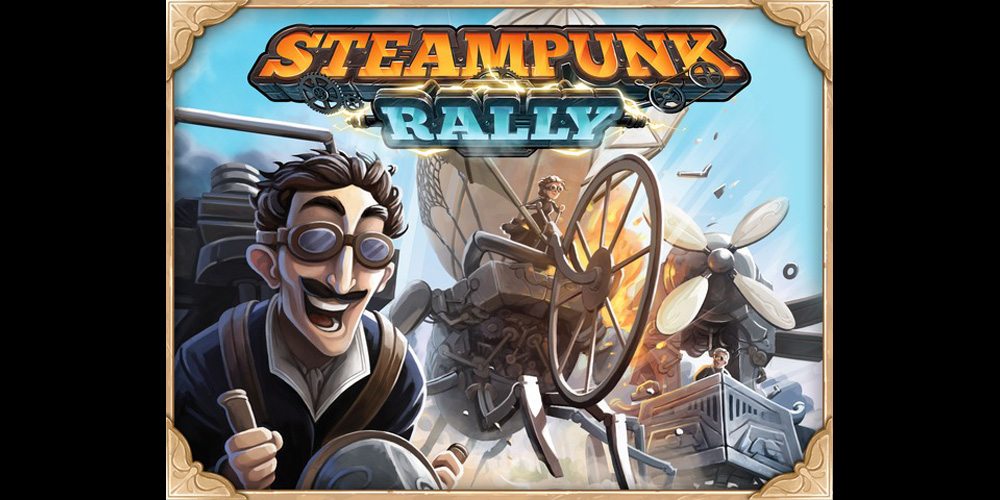Nikola Tesla, Marie Curie, and George Washington Carver walk into a board game… no, it’s no joke. Steampunk Rally is a game that pits these brilliant minds (along with Thomas Edison, the Wright Brothers, and Guglielmo Marconi) against each other in a madcap race to Bern, using contraptions built on the fly. I mentioned it in my recent Kickstarter Tabletop Roundup; here’s a closer look at how the game works.
At a glance: Steampunk Rally is for 2 to 6 players (up to 7 if a stretch goal is reached), ages 13 and up, and takes about 45 minutes to play. The pledge level on Kickstarter for a copy of the game is $55 CAD (roughly $49 USD), with an estimated delivery date of December 2014.
New to Kickstarter? Check out our crowdfunding primer.
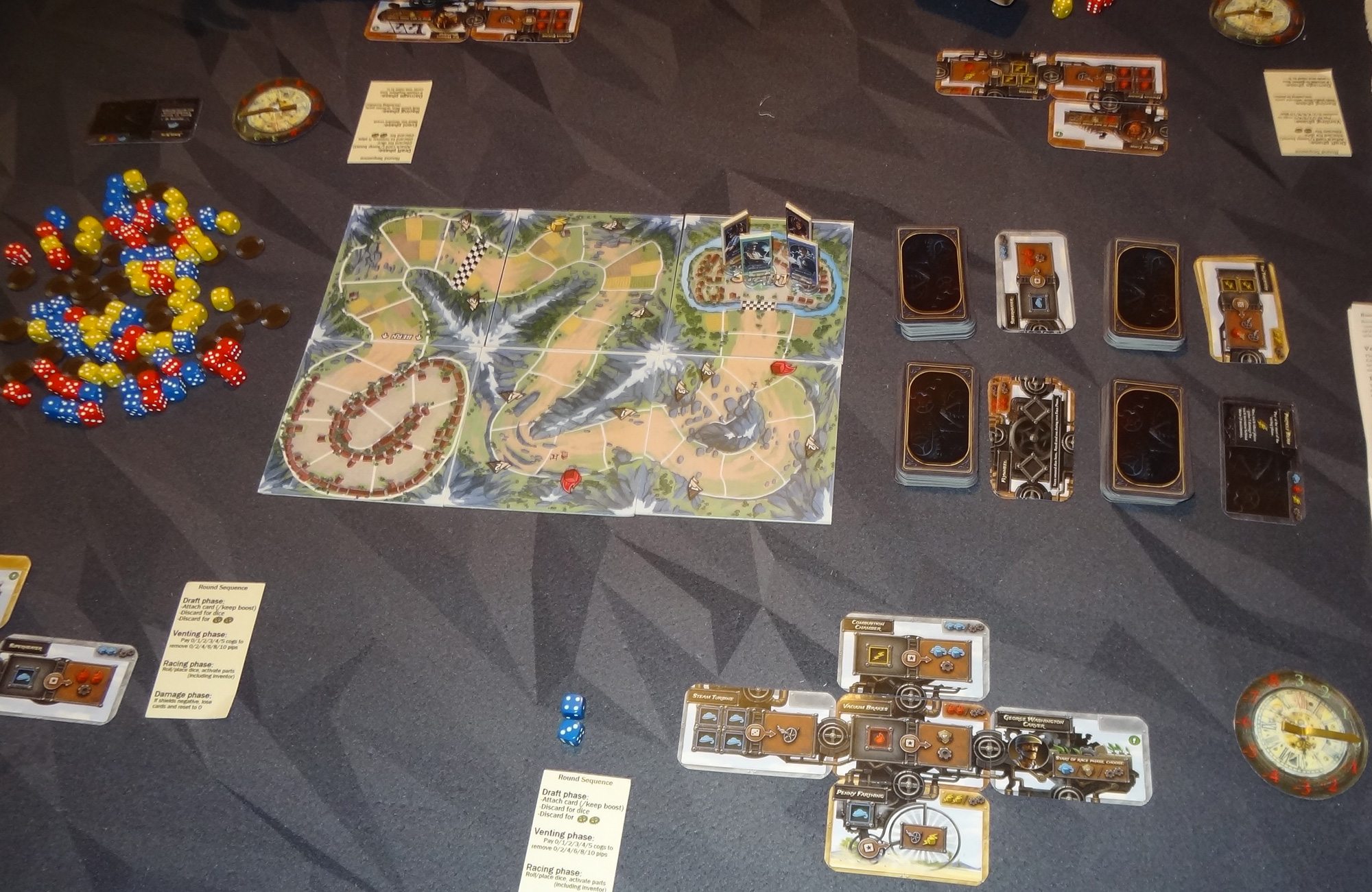
Components
- 84 dice (in 3 colors)
- 108 Machine Part cards
- 36 Boost cards
- 12 Inventor cards (2 each for 6 Inventors)
- 6 Inventor tokens
- 6 Damage Gauges
- 7 Track tiles
- 40 Cog tokens
This is the current component list, though if stretch goals are reached there might be more inventors, dice, and enough components for 7 players.
The version I played was a demo prototype, so it just used small plastic poker chips for the cogs and some of the components were just printed on cardstock. However, the artwork for the cards was pretty much complete, and the machine parts look great. There are lots of fun little details, particularly on the Inventor cards. For instance, George Washington Carver’s cockpit has peanut plants on it.
Each of the machine part cards has valves on one or more sides, which can be used to connect the machines together. There are three types indicated by the borders: gold always includes movement, silver always produces more dice, and copper always has valves on all four sides for making connections.
The black Boost cards are not machine parts, but instead have various one-time effects when you use them, usually helping you or harming your opponents, but some have global effects that help or harm everyone at once.

How to play
The lastest draft of the rulebook is available as a PDF here.
The goal of the game is to win the race—as soon as somebody crosses the finish line, there is one more round of play, and then the player who has advanced the farthest toward Bern wins the game.
To set up, you’ll set up six of the race tiles—the start, finish line, and Bern, plus three others chosen at random. Each player chooses one of the inventors and takes the two cards associated with it: one has the inventor in a cockpit and automatically generates resources each turn; the other provides a basic form of locomotion. Your Damage Gauge is set to 0 at the beginning of the game.
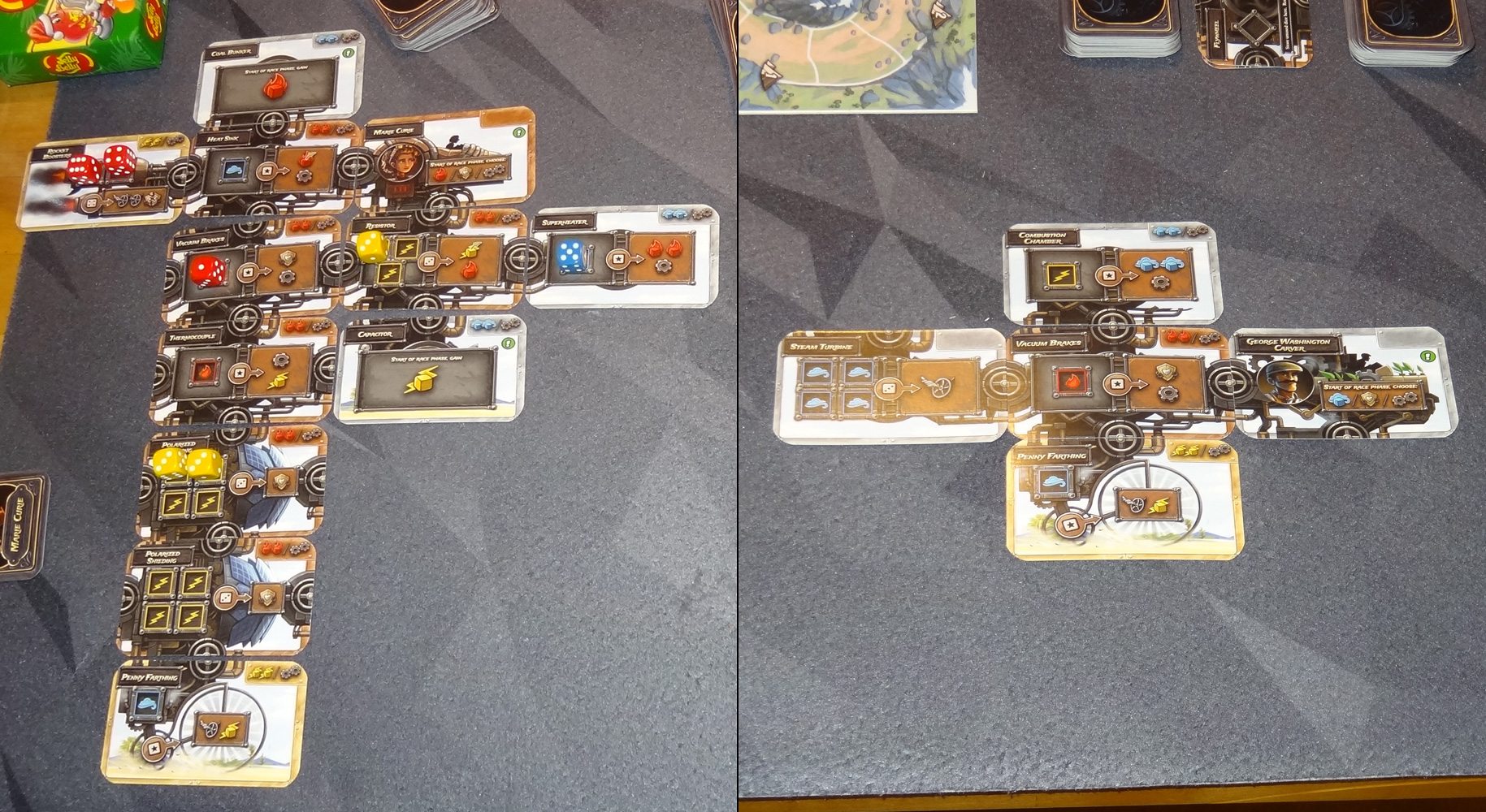
Each round has several phases: Drafting, Venting, Racing, and Damage.
For the Drafting phase, every player takes four cards, one from each deck (Gold, Silver, Copper, Boost). Then you pick one to play, pass the rest, and simultaneously reveal your chosen cards. Each card may be used for one of the following purposes:
- Construct: add the part to your machine—you may rearrange cards as needed, but all cards need to be connected somehow to each other. (Boost cards aren’t added to the machine, but set aside to be played later.)
- Resources: Discard the card to gain either 2 cogs or the dice indicated. Gold, Silver, and Copper each get you two dice of a particular type; Black cards may be traded for a single die of any color.
When everyone has used their chosen cards, they pick up the cards that were passed to them and repeat this process until each player has used four cards.
Next is the Venting phase, which doesn’t really come into play until the second round. You may spend cogs to remove pips from the dice on your machine. Each cog removes two pips, either from the same die or two different dice. When a die has all its pips removed, it is removed from the machine and discarded. You do this to clear up spaces on your machine so you can place more dice later.
The Racing phase is where most of the action occurs, and it’s done simultaneously by all players. First you roll all the dice you’ve collected as resources during the Drafting phase, as well as any that are generated automatically by your machine (such as by your Inventor card). Then you may spend these to power your machine.
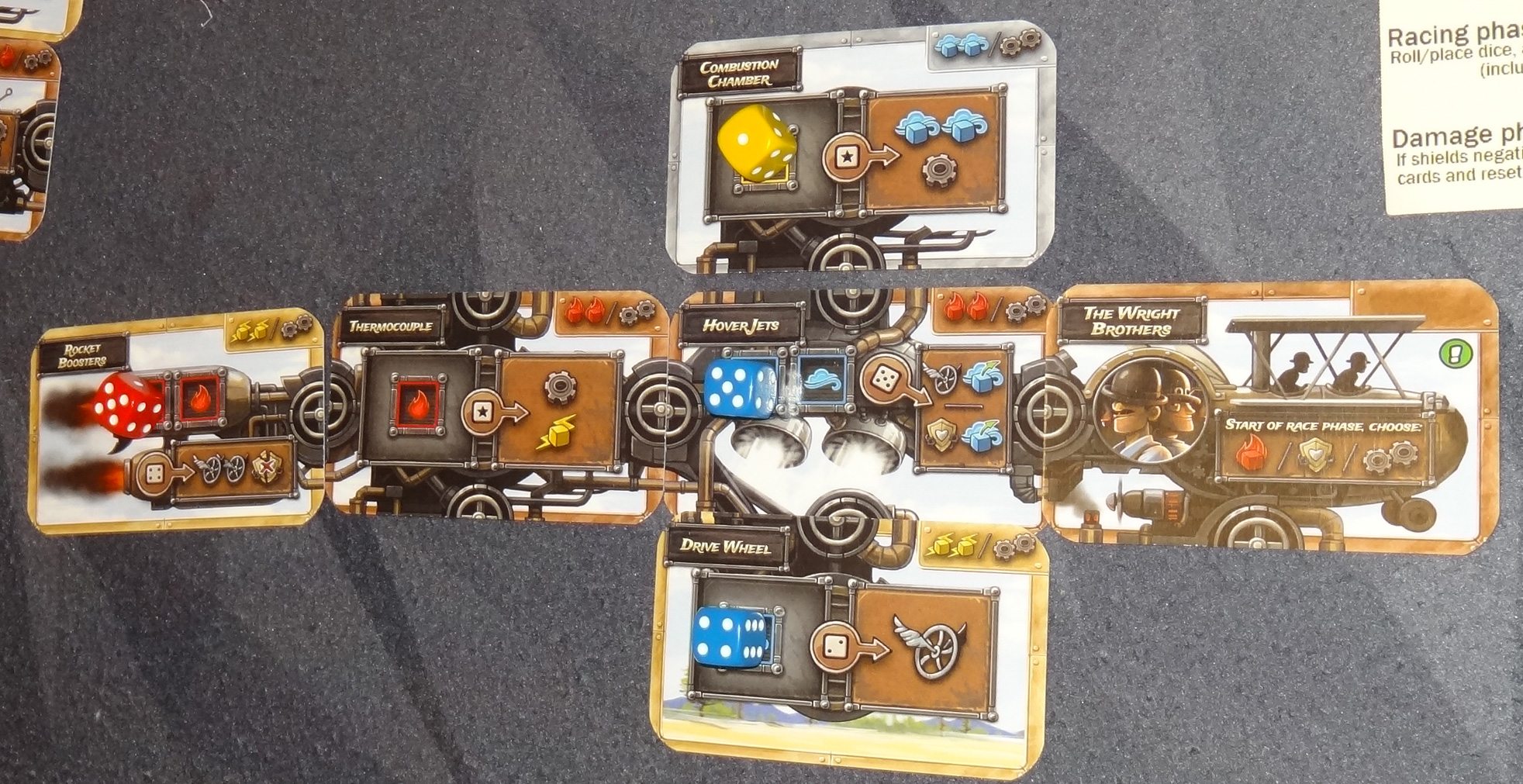
The machine parts will show which color dice are needed to activate a part, and then what happens when it is activated. Some will generate dice or cogs, which you take from the supply. Others generate shields, which you track on your Damage Gauge. And, of course, there are parts that give you movement, which sends you along the racetrack. (There are some more details about how the dice are used, but I won’t get into those here.)
During the Racing phase, cogs may be spent either to re-roll dice that aren’t placed yet or to add 1 pip to a die. If you’re on a space on the track that shows a die, you may also spend cogs to purchase dice of that color.
As you move into spaces that have terrain, you’ll take damage, tracking it on your Damage Gauge. Once everyone is done with their Racing phase, each player looks at their Damage Gauge. If you’re below 0, then you must discard 1 part of your machine for every point of damage, and then set your gauge back to 0. Dice are discarded along with the machine parts.
Finally, any dice that weren’t placed onto your machine are discarded back to the supply, and a new round begins.
When one player crosses the finish line, you play one more full round, and then the game ends. The player farthest along the track wins the game.
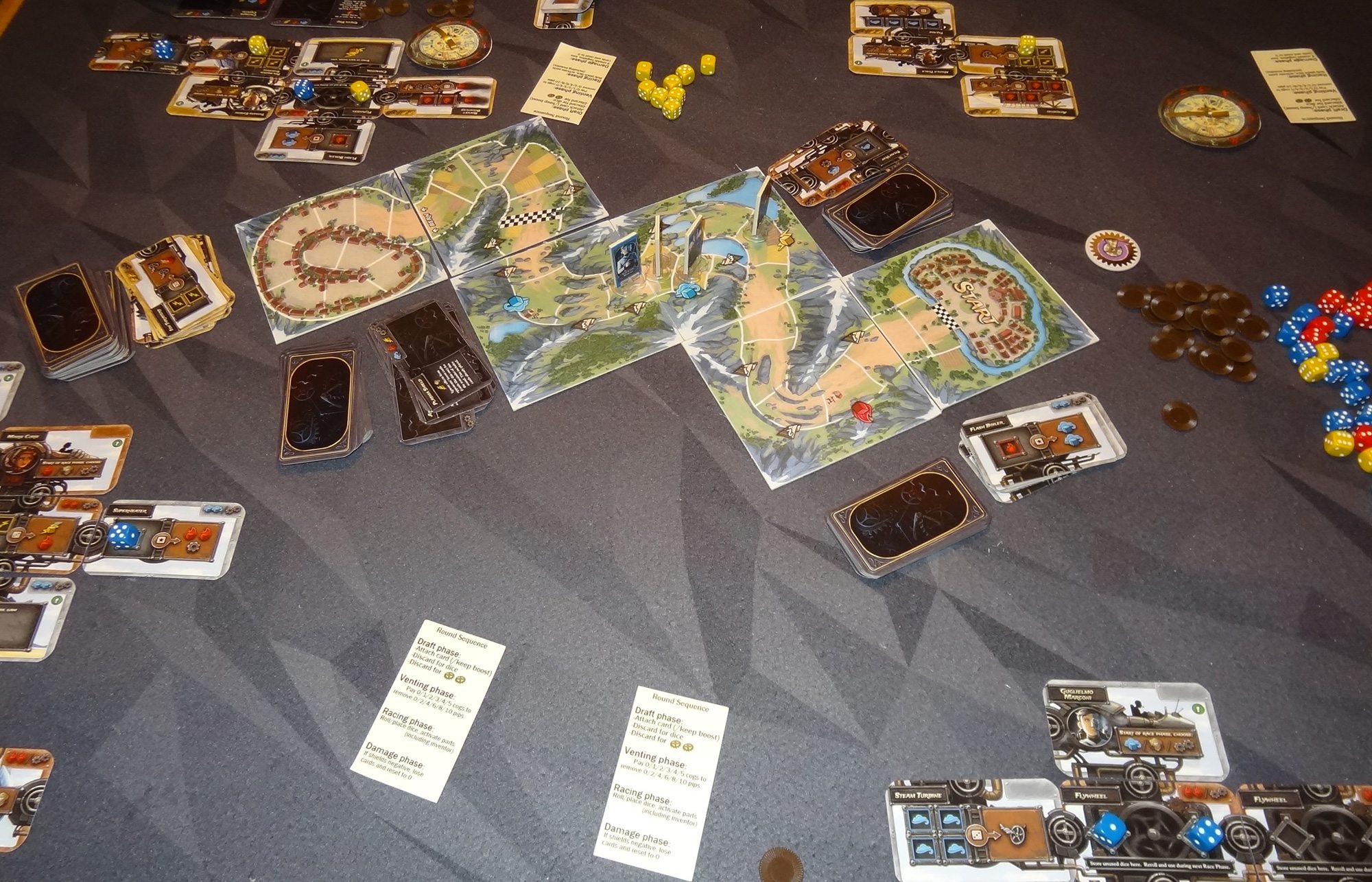
The Verdict
If you like building things, you’ll get a kick out of Steampunk Rally. The best part of the game is building up all the wacky machines and imagining how they function. Sometimes you’ll have an enormous tower balanced on a penny farthing wheel, or a contraption that has both tank treads and hover jets. It’s even fun to take damage and have parts of your machine fall off, because you can just pick up some more and tack them on during the next round.
The dice-placement and venting mechanic is also pretty clever. You’ll need dice to power your machine, and you have to make some tough decisions during drafting: do you trade in cards for dice? Or do you use them as machine parts, hoping to get some other parts later that will generate the dice you need? For many parts, placing higher-valued dice will let you move farther, but then it also means you’ll need to spend more cogs to vent those dice and remove them so you can use that part again. There’s a tricky balance that makes for a lot of different ways to play.
The downside is that this can lead to some analysis paralysis, particularly if you have an enormous machine. You might be able to take one red die, generate two blue ones, which are then used to generate yellow dice, but if you roll high enough on this other yellow die then you should get some cogs instead, and … that can be the danger. The game works better (and plays more quickly) when people remember that they’re piloting kludged-together machines and don’t try to run a possibility tree on every move.
Although there are some cards that let you attack other players, most of the Boost cards are just beneficial to you, and some even benefit everyone. Sometimes, though, it’s just as useful to turn Boost cards in for cogs or dice, depending on what you have already.
The rules for Steampunk Rally only run two pages (plus a third page showing a gameplay example), which is pretty impressive for a game that doesn’t feel simplistic when you play it. That makes it relatively easy to teach, but it still provides a lot of fun and juicy decisions even for more experienced gamers.
Whether you like the steampunk genre or not, if you like the idea of building your own wacky vehicle and racing against other famous inventors, you won’t want to miss Steampunk Rally.
For more information, visit the Steampunk Rally Kickstarter page.
Disclosure: GeekDad received a demo prototype of this game for review.
